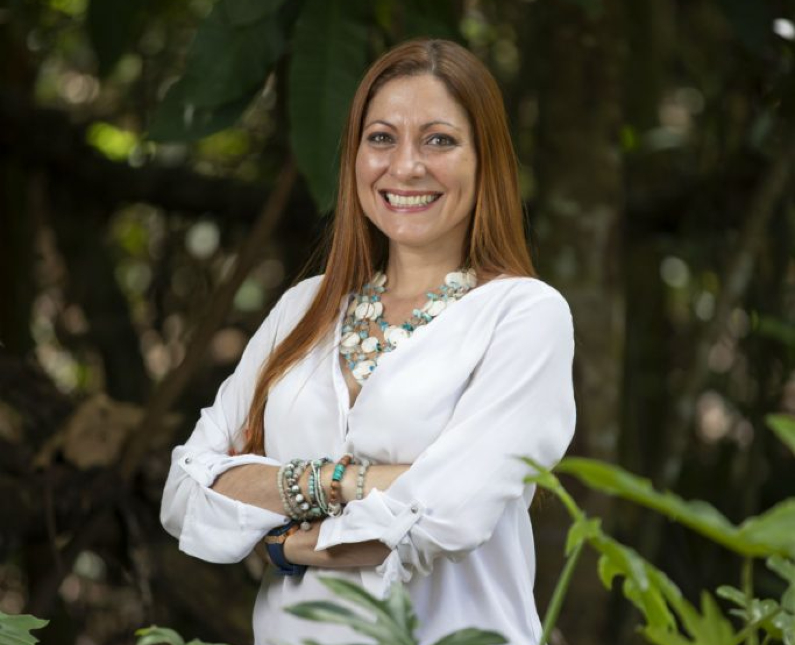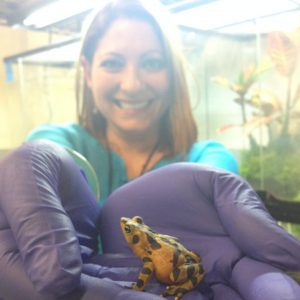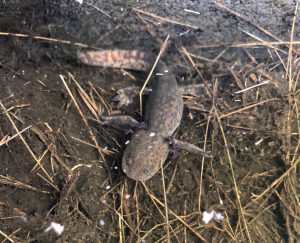As a woman in conservation, Gina Della Togna, a member of the Mohamed bin Zayed Species Conservation Fund Advisory Board, has navigated numerous stereotypes throughout her journey. An exceptional researcher and conservationist, she serves as the Executive Director of the Amphibian Survival Alliance and is also a Research Associate at the Smithsonian Tropical Research Institute. We had the opportunity to catch up with her to learn more about her inspiring conservation journey and discuss the latest MBZ Fund Dolphin Energy Chairman’s Award, focusing on the Axolotl.
Editor: Could you share a little about your background and journey?
Gina Dela Togna: As you see from the introduction, I’m the Executive Director of the Amphibian Survival Alliance and a Research Associate at the Smithsonian Tropical Research Institute. I earned my Ph.D. in Biological Sciences, specializing in Molecular and Cell Biology, from the University of Maryland, USA. My work has primarily focused on the reproductive biology of amphibians, with an emphasis on developing Assisted Reproductive Technologies (ARTs) for endangered species facing reproductive challenges.
Since 2017, I have served as co-Chair of the IUCN SSC Amphibian Specialist Group ARTs and Biobanking Working Group and co-authored the Amphibian Conservation Action Plan (ACAP). I am also part of the IUCN SSC ASG Atelopus Task Force and the Atelopus Survival Initiative, where I co-chair the Ex-Situ Working Group. Additionally, I contribute to the Advisory Boards of the Mohamed bin Zayed Species Conservation Fund and Re:wild’s Fonseca Species Conservation Fund and serve on the 2024-2032 Executive Committee of the World Congress of Herpetology.
ED: Oh wow, that is an incredible track record. Have you faced any obstacles along the way?
GDT: Absolutely, my journey has been both rewarding and challenging. As a Latin American woman, I have faced and had to overcome stereotypes while navigating my path in conservation. Along the way, I’ve had the privilege of collaborating with incredible individuals who have inspired and supported my work. These experiences have shaped me into the professional and mentor I am today, committed to driving forward initiatives that safeguard amphibian populations.
ED: What sparked your passion for amphibians?
GDT: My passion for amphibians stems from their incredible biodiversity, their essential role in ecosystems, a lifelong fascination with nature and a deep curiosity about how natural systems function. From a young age, I knew I wanted to study life, which naturally led me to pursue a career in biology. Growing up in Panama, I was surrounded by amphibians—they were a constant presence in backyards, on streets, and filling the night with their calls. However, over time, their numbers began to dwindle, and the once-vibrant nights became quieter.
When I began my Ph.D. in 2008, it was just a few years after the first Amphibian Conservation Summit in 2005, where the initial Amphibian Conservation Action Plan was conceptualized. At the time, there was an important need to develop and implement conservation strategies based on the first ACAP. At the same time, Panama was grappling with the devastating effects of the fungal disease Chytridiomycosis, which had a catastrophic impact on amphibian populations, including one of our national symbols, the Panamanian Golden Frog, which is currently believed to be extinct in the wild. Witnessing this crisis firsthand deeply influenced my commitment to amphibian conservation.
My passion is fuelled by the urgent need to address the threats they face. I am dedicated to a lifelong mission of promoting amphibian conservation, mitigating the extinction crisis, and working tirelessly to help these extraordinary creatures thrive once again.
ED: When did you first discover the Mohamed bin Zayed Species Conservation Fund?
GDT: I first discovered the Mohamed bin Zayed Species Conservation Fund around 2011, during my Ph.D. program. Some collaborators were searching for funding opportunities and mentioned the Fund in a department meeting. At the time, I wasn’t familiar with it, likely because it had been recently established. Curious, I researched the initiative and was immediately impressed by its mission and commitment to supporting global multi-taxon conservation efforts.
Over the years, my admiration for the Fund has only grown, particularly for the impactful way it empowers conservation projects worldwide. It’s a tremendous honour to now be part of such a remarkable organization, contributing to its vital mission. It allows me to work alongside remarkable professionals and learn from their expertise, further fuelling my passion for conservation and my dedication to creating a brighter future for amphibians and the ecosystems they inhabit.
ED: Recently, an Axolotl project received a Chairmans Award supported by Dolphin Energy. What aspects of this project captured your interest?
GDT: First of all, Axolotls are fascinating creatures that captivate the imagination with their unique ability to regenerate lost body parts, such as limbs, spinal cords, and even parts of their hearts and brains. Endemic to the lakes and rivers of Mexico, these aquatic salamanders remain in their larval stage throughout their lives, a condition known as neoteny, which gives them their distinctive and adorable appearance. Their charming external gills and wide, “smiling faces” make them stand out from other salamanders. Their resilience and adaptability make them truly extraordinary members of the animal kingdom.
The recently published Second Global Amphibian Assessment (GAA-2) determined that two out of every three salamander species (60%) are threatened with extinction, making them the most threatened group of amphibians currently. This project focused on the species Ambystoma leorae. The genus Ambystoma is among the 25 exceptionally threatened genera from the Neotropics. This species is Critically Endangered because its extent of occurrence is only 10 km2, including three streams, two of which have almost disappeared.
This species is of such importance that it is the only trigger of the Volcanes Itzaccíhuatl-Popocatépetl AZE site. What captured my interest most about this project is its multifaceted approach to an urgent crisis. The species faced a dire threat when two of its three streams dried up during the extreme drought in mid-2024. The team’s swift response combined an emergency action plan grounded in solid science with a community-driven initiative. This collaboration highlights the dedication of both conservationists and local communities to protecting their natural resources and biodiversity. The project’s ability to prevent the imminent extinction of the species is invaluable. Through this effort, the Mohamed bin Zayed Species Conservation Fund, supported by Dolphin Energy, has played a pivotal role in averting a conservation tragedy, underscoring the Fund’s critical impact in safeguarding global biodiversity.
ED: That’s amazing, the Axolotl sounds like an interesting creature. What makes this Dolphin Energy supported project unique?
GDT: What makes this project truly unique is its holistic, community-driven approach to conservation. It seamlessly integrates habitat restoration, ex situ conservation, species reintroductions, and education, creating a comprehensive framework for safeguarding biodiversity. Remarkably, the community has not only donated land for the ex-situ program but will also take on its long-term management after receiving proper training. This level of local involvement demonstrates a profound sense of stewardship and commitment to the species’ survival. Beyond preventing the extinction of a critically endangered species, the project will generate invaluable biological data to inform long-term conservation strategies. The active role the community plays is particularly noteworthy, as it underscores the principle that effective conservation hinges on the engagement and support of local stakeholders—a principle this project embodies exceptionally well.
ED: That’s amazing, to see how collaborations between community, conservationists and caring Corporates can drive impactful conservation results.
ED: Talking about amphibians, do you have a favourite amphibian, and why?
GDT: I have many favourite amphibians, as they are a stunningly beautiful and remarkably diverse group of animals with mind-blowing strategies and adaptations. However, the one closest to my heart is the Panamanian Golden Frog (Atelopus zeteki), a Critically Endangered species believed to be extinct in the wild since 2009. This species is not only one of Panama’s national animals but also a cultural and ecological icon with enormous value both nationally and internationally.
According to pre-Columbian lore, Panamanian Golden Frogs turn to solid gold when they die, and many Panamanians believe that spotting one brings good luck. Their image is ubiquitous, appearing on everything from lottery tickets to guidebooks. On the upper reaches of “La India Dormida” (the Sleeping Indian) mountain in El Valle, Panama, a petroglyph of a frog, believed to date back to before the 1400s, stands as one of the earliest tributes to this extraordinary animal. Panama even celebrates a National Panamanian Golden Frog Day on August 14th, making it one of only three countries in the world to honour an amphibian as a national symbol with such deep cultural roots. This unique connection between nature and culture underscores why the Panamanian Golden Frog holds such a special place in my heart—it represents resilience, heritage, and the vital importance of conserving our natural treasures.
ED: That’s an incredible story and sounds like a unique species
ED: What are some of your interests or passions beyond conservation?
GDT: Beyond conservation, one of my greatest passions is mentoring the next generation of scientists and conservationists. I believe education is a powerful tool for change, and I’m deeply committed to fostering growth and inspiration in others through knowledge sharing.
On a personal level, I prioritize health and well-being by working out regularly, eating mindfully, and dedicating time to personal growth. I also have a deep love and respect for my pets, who bring immense joy and companionship to my life. Lastly, I enjoy the creative and relaxing process of making handmade soap—a hobby that allows me to blend artistry with sustainability.
ED: Oh wow, your last answer sums up this incredible interview. Thank you for the colourful look into your life and this incredible insight into amphibians and your passion to preserve them. Please keep shining and keep inspiring.
GDT: You are most welcome and thank you for the opportunity




